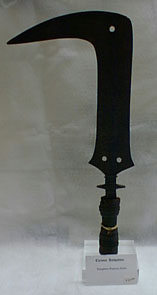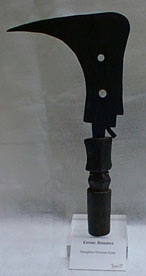|
|





Azande
Expansion through warfare is the heritage of the Azande, a Sudanic people who migrated to the Congo in the 18th century driving out the Mangbetu and pygmies and systematically destroyed or assimilated their neighbors. Initially unilaterally victorious, repeated conflict with the Mangbetu to the South produced mixed results and considerable cultural exchange. War was waged both by surprise raid and fully organized campaign. The configuration of the weapons of the Azande has long been the subject of speculation and perhaps is best summed up by Spring who suggests that attempting to attribute form to function is a Western concept which should not necessarily be applied. Truly, the charm and mystery of these and other African weapons is due in large part to the fact that we have yet to understand them. As research progresses, new understanding gives greater value to every example.